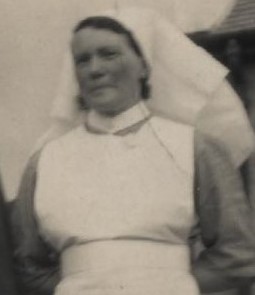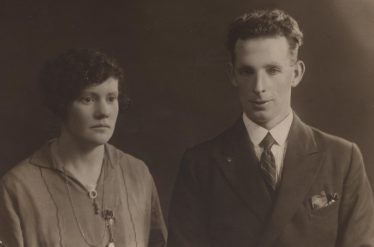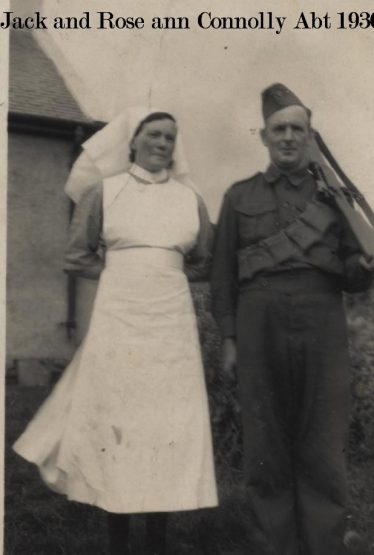08 Nurse Roseanne Connolly - A Ballinrobe Star



Roseanne Connolly was a district nurse/midwife in Ballinrobe, County Mayo, from 1941 through to the 1960s. She, her husband, Jack, and three children returned home to Ireland from England in 1933. She worked as a district nurse in Tourmakeady before being transferred to Ballinrobe. The family lived in Abbey Street.
Birth
Roseanne was born to Dominick and Catherine Kilroy in Belmullet in 1891, the same year in which Pope Leo X111, by one stroke of his papal pen in the encyclical “Rerum Novarum” defined the role of women thus, “a woman is by her nature fitted for homework and it is this which is best adapted to preserve her modesty and promote the good upbringing of children and the wellbeing of the family.” This and subsequent pastoral letters issued by Irish bishops ensured that this definition became enshrined in state policy and had a detrimental influence on women’s lives for many decades.
Brother
Roseanne’s brother Jim and cousin Michael fought in the War of Independence and the Civil War and Jack Connolly, born in Newport in 1886, formed part of Michael’s IRA flying column, so Jack may have been known to Roseanne in her youth, they may even have been childhood sweethearts. In 1923 Jack escaped from Galway jail, where he was incarcerated by Free State forces, and after lying low for a while, emigrated quietly to England. He married Roseanne in London in 1927.
Return to Ireland
Nurse Connolly, whose husband and family had fought for Irish freedom, must have been somewhat dismayed at the state of the Ireland she came home to. Conservative male legislators, in line with church teaching, decided that a woman’s place was in the home, cooking, cleaning, being an obedient wife, giving birth and rearing godfearing children. A marriage bar was in place preventing married women in the civil service and in teaching from retaining their jobs on marriage, books and films which were considered contrary to the moral code were censored, contraception was banned, sex was allowed for procreation only. Unmarried mothers were labelled promiscuous, a shame to family and society, they had to be hidden away in institutions until they reformed; in the throes of labour there was little sympathy for them, being told to push hard and pray, and they had no right to retain their babies. Giving them state financial support or treating them with compassion was out of the question until the 1970s. Unmarried fathers on the other hand bore no responsibility, they usually denied paternity and vanished. The new Irish Free State disposed of people society didn’t want, in mental hospitals, magdalene laundries, reform and industrial schools, orphanages and prisons.
Attended to all
Nurse Connolly attended without discrimination to the needs of all, rich, poor and marginalised. Many of her patients suffered from tuberculosis, at that time a major problem causing prolonged illness and death. Wearing a belted navy mac, she rode around the town visiting patients on her High Nellie or travelled out the country with a local doctor during the war years in pony and trap, petrol being one of the many commodities to be rationed. On her hands and knees she crawled on winter nights into traveller encampments to attend to itinerant mothers giving birth in dreadful conditions. They were sometimes intoxicated making the births more difficult, but who could blame them for trying to blot out their pain and misery, whiskey or poitin substituting for the epidural of today. Rose understood their plight, cared for them equally, and never reprimanded them nor spoke ill of them.
Her Patients & Comparisons
Many of her patients were country women living in poverty and squalor in cottages with no piped water, dim light from a paraffin lamp and poor sanitation. They had large families, child mortality rates were high, they eked out an existence on small holdings of scrub land, working in the fields as well as in the home. Contrast their situation with that of the present day where moneyed mums-to-be, on discovering they are pregnant, reserve a suite in a 5* hospital, the services of an expert obstetrician who will deliver baby by C-section leaving a miniscule scar. The babies will wear Armani or Lauren onesies and be looked after by nannies.
Cloth Nappies
In Roseanne’s time, there were no babygros, onesies, pampers or baby designer gear and out of kindness she often bought matinee coats, vests and cloth nappies in Biggins’s drapery shop in town for the babies of impoverished mothers, without ever asking for payment though her salary was meagre.
Travelled out to her Patients
She travelled in an old Zephyr Zodiac car with Doctor McDarby to isolated cottages in the hill country to the west of Ballinrobe to attend the sick and deliver babies. Sometimes, the last part of the journey was no more than a mountain track and had to be negotiated on foot. On one occasion, in Tourmakeady, Rose did not travel home with the doctor, but insisted on staying the night with the mother who had endured a long and painful birth, and when morning came, she went to the stable and milked the cow, ensured that the family had breakfast and that the new mother had regained her strength before going home.
A Shining Star
Roseanne Connolly was a shining star in a dark firmament, a Florence Nightingale at a time when many irish women were struggling against poverty and the laws of church and state for liberation and equality. She is spoken of as a saint, patient, caring, compassionate, competent, a kind, discreet, lady who went above and beyond the call of duty, who is remembered by all who knew her with fondness and gratitude, an unsung heroine. Her husband, Jack, is remembered as a quiet man, inoffensive, cheerful and a skilled builder, having worked in construction in England. He did not speak publicly about his fight for Irish freedom and, like all survivors, I am certain that he took with him to his grave the bitter memories of the Civil War.
Death
Rose died in 1988, Jack in 1985. They are buried in Ballinrobe cemetery.
Further information:
To read about Jack Connolly and their families see article on our linked site: National Museum of Ireland “Our Irish Heritage”: https://bit.ly/2qDBJUd

Comments about this page
I remember my father, Jim Farragher telling me, he had often driven Nurse Connolly to people in need of her help. He spoke of her good work, at a campsite on the side of the road and the only light she had was the lights from his car. She was a super woman. She also had beautiful flowers in her garden at her home on Abbey St. and she was so generous in giving them, which were displayed in the Catholic Church regularly. She was such a kind, friendly person.
Add a comment about this page